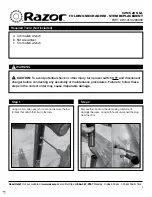
7
6
SHIFTER/DERAILLEUR
SHIFTER
This E-bike is equipped with gears, that include:
• A rear sprocket cluster called a freewheel or cog set
• A rear derailleur
• One shifter
• One control cable
• One front sprocket
• A drive chain
There are many different types of shifter mechanisms, each preferred for specific
applications because of their ergonomic, performance and price characteristics.
A downshift is a shift to a lower or slower gear, which makes it easier to pedal.
An up-shift is a shift to a higher or faster gear, which makes it harder to pedal.
For example, you can downshift to a lower gear to make pedalling easier on a hill.
On the other hand, you may up-shift to a higher gear when you wish to go faster.
Whether up-shifting or downshifting, the derailleur system requires that the drive chain
is moving forward and is under at least some tension. A derailleur will shift only if you
are pedalling forward.
CAUTION: NEVER MOVE THE SHIFTER WHILE PEDALLING BACKWARD.
DO NOT PEDAL BACKWARDS AFTER MOVING THE SHIFTER. EITHER OF THESE
ACTIONS COULD JAM THE CHAIN AND CAUSE SEVERE
DAMAGE TO THE E-BIKE.
Shift the rear shifter to the highest number indicated,
loosen the cable from the rear derailleur cable anchor
bolt, and place the chain on the smallest sprocket.
Adjust the high limit screw so that the guide pulley
and the smallest sprocket line up vertically.
Re-tighten the cable, pull out any slack and re-tighten
the anchor bolt securely. When shifting through the
gears, make sure that each gear changes quietly and
without hesitation. It is necessary to use the barrel
adjuster to fine-tune the cable tension by turning it in
the direction you want the chain to go. For example,
turning clockwise will loosen the cable tension and
move the chain away from the wheel, while turning
counter-clockwise will tighten cable tension and
direct the chain to the wheel.
DERAILLEUR
The derailleur system includes the front and rear derailleur, the shift levers, and the
derailleur control cables, all of which must function correctly for smooth gear shifting to
occur. The front and rear derailleurs are adjusted in the factory. You will need to
inspect and adjust both before riding your E-Bike.
ADJUSTING THE REAR DERAILLEUR
ADJUSTING THE FRONT BRAKES
1. Insert an elbowed hex key into the screw port of the brake frame, turning the screw
left to loosen and right to tighten. Turn to the left gently makes the brake a little loose.
2. Hold the brake tight with your left hand so that the brake is pressed against the brake
pad (this holds the brake tight).
3. Then turn the elbowed hex key to the right of the brake until the brake is tight, then
release the brake. The brake will automatically return, the brake is in the right direction,
so that it will not wear.
To adjust the saddle (up or down) open the quick-release lever on the saddle tube.
Once you choose the correct height, close the quick-release lever. Press down on the
saddle to make sure it is locked tight into position. To check for correct saddle height,
perform the following:
• Sit on the saddle, and place one heel on a pedal.
• Rotate the crank until the pedal with your heel on it is in the down position, and the
crank arm is parallel to the seat tube. Your leg should be completely straight and just
touching the center of the pedal.
ADJUSTING THE SADDLE
Some riders prefer to have the saddle nose tilted
slightly up or down. Adjust the saddle tilt by loosen-
ing the saddle bolt, tilting the saddle to the desired
position, and re-tightening the saddle bolt. Make sure
it is tight enough so that you cannot move or jiggle
the saddle. Small changes in saddle position can have
a substantial effect on performance and comfort.
Whenever changing your saddle position, make
only one directional change at a time.





























